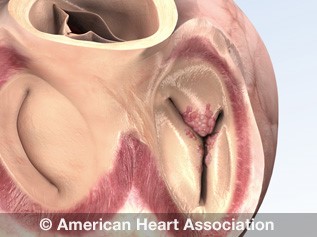Heart Valves and Infective Endocarditis
What is infective endocarditis?
Infective endocarditis (IE), also called bacterial endocarditis, is an infection caused by bacteria that enter the bloodstream and settle in the heart lining, a heart valve or a blood vessel. IE is uncommon, but people with some heart conditions have a greater risk of developing it.
Infective endocarditis refers to infection in the lining of the heart, but it also affects the valves. It often affects the muscles of the heart.
View an illustration of endocarditis.

There are three forms of infective endocarditis:
- Acute IE — develops suddenly and may become life threatening within days.
- Subacute or chronic IE (or subacute bacterial endocarditis) — develops slowly over a period of weeks to several months.
- Prosthetic valvular IE – develops within a year after heart valve replacement.
How do people contract infective endocarditis?
The infection can be caused by bacteria introduced into the blood stream. Infection can result from many sources, including poor dental hygiene, tooth brushing that causes minor injury to the lining of the mouth or gums, dental procedures, implanted cardiovascular medical devices, chronic skin disorders and infections, burns, infectious diseases, intravenous drug use and more. These bacteria can lodge on heart valves and cause infection of the endocardium.
Why does endocarditis pose a threat to the heart valves?
Bacteria can grow on the valves and it is difficult to fight this infection, whether through the body’s own immune system or through medications that rely on the blood system for delivery. This results in complications such as embolization or valve destruction.
Who's at risk for infective endocarditis?
Risk factors for children and young adults include birth defects of the heart such as malformed valves or a hole in the septum, which allow blood to leak from one part of the heart to another.
Risk factors for adults include older age, previous heart valve disease, valve surgeries or a heart transplant, having a cardiac device in place (pacemaker or ICD), calcium deposits in the aortic valve, congenital heart defects, history of endocarditis, or poor care of the teeth and gums.
Illicit drug use and IE
If the cause of IE is injection of illicit drugs or prolonged use of IV drugs, the tricuspid valve is most often affected. Street drugs, including narcotics, can also affect the mitral or aortic valve.
What are the symptoms of infective endocarditis?
The symptoms of acute IE usually begin with fever, chills, fast heart rate, fatigue, night sweats, aching joints and muscles, persistent cough or swelling in the feet, legs or abdomen.
The symptoms of chronic IE may include fatigue, mild fever, a moderately fast heart rate, weight loss, sweating and a low red blood cell count (anemia).
Treatment
Treatment usually consists of IV antibiotics. The choice of antibiotic and the length of treatment is based on the type of infection causing the endocarditis. Surgery may be needed for mechanical complications or resistant organisms.
Prevention for those at risk usually involves awareness of the risks, appropriate dental care and heart healthy habits.
Related links:
- Dental procedures and infective endocarditis
- Print our IE wallet card (PDF)
- Printable patient sheet: What is Endocarditis? English (PDF) | Spanish(PDF)





